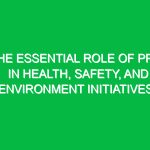In today’s industrial landscape, ensuring the safety and health of workers is paramount. One of the key strategies employed to achieve this is through local exhaust ventilation (LEV). This system plays a critical role in managing airborne contaminants, thereby reducing potential health risks in various work environments. In this article, we will explore what local exhaust ventilation entails, the associated hazards and risks, safety precautions, best practices, and the regulatory framework governing it. Our aim is to provide a comprehensive understanding of LEV and its significance in the Health, Safety, and Environment (HSE) domain.
What is Local Exhaust Ventilation?
Local exhaust ventilation refers to a system designed to remove contaminants from the air at their source before they can disperse into the workplace atmosphere. LEV systems typically consist of hoods, ducts, fans, and filters, all working in conjunction to capture hazardous substances such as dust, fumes, vapors, and gases. The primary goal is to protect workers by minimizing their exposure to harmful airborne pollutants.
LEV is particularly relevant in industries such as manufacturing, construction, and healthcare, where workers often encounter hazardous materials. For instance, a metal fabrication shop might use LEV to capture welding fumes at the source, preventing them from accumulating in the air and endangering employees’ health. The effectiveness of LEV can significantly enhance workplace safety, making it a vital component of any comprehensive HSE strategy.
Identifying Hazards and Risks Associated with Local Exhaust Ventilation
While local exhaust ventilation is designed to enhance safety, there are inherent hazards and risks associated with its design, installation, and operation. Understanding these risks is crucial for optimizing LEV systems and ensuring worker safety.
1. Inefficient Capture of Contaminants
If the LEV system is not appropriately designed or maintained, it may fail to capture airborne contaminants effectively. For example, a poorly positioned hood may not capture all the fumes generated during a welding process. This inefficiency can lead to elevated exposure levels for workers, increasing the risk of respiratory issues or other health problems associated with inhaling hazardous substances.
2. System Failures
Mechanical failures can pose significant risks. A malfunctioning fan or a clogged duct can severely impair the system’s performance. In a case study involving a chemical manufacturing plant, a fan failure went unnoticed, leading to increased exposure to toxic vapors. Regular maintenance and monitoring are essential to prevent such occurrences.
3. Inadequate Training and Awareness
Workers must be adequately trained to use LEV systems effectively. Lack of knowledge about how to operate the system or recognize its importance can lead to improper usage. For instance, if employees are unaware of the need to adjust hood positions based on their tasks, they may inadvertently increase their exposure to hazardous materials.
4. Environmental Impact
Improperly designed LEV systems can also contribute to environmental pollution. If the extracted air is not filtered or treated correctly before being released back into the atmosphere, it can lead to contamination of the surrounding environment. This can have broader implications for community health and safety, highlighting the need for responsible LEV management.
Safety Precautions and Best Practices for Local Exhaust Ventilation
To mitigate the risks associated with local exhaust ventilation, several safety precautions and best practices should be implemented. Here are some actionable steps that can be taken to optimize LEV systems:
1. Conduct Regular Assessments
Regular assessments of the LEV system are vital to ensure its effectiveness. This includes testing airflow rates, inspecting ducts for leaks, and checking the condition of filters. A well-maintained system will perform better and ensure that contaminants are effectively captured. According to the American National Standards Institute (ANSI), these assessments should occur at least annually or more frequently based on usage and types of contaminants.
2. Optimize Hood Design and Placement
The design and placement of the exhaust hood are critical for maximizing contaminant capture. Hoods should be positioned as close to the source of contamination as possible, while also allowing for adequate worker movement. For example, in a woodworking shop, hoods should be mounted directly over cutting tools to capture wood dust effectively. Using adjustable hoods can also provide flexibility for different tasks, enhancing safety.
3. Ensure Proper Training
Comprehensive training programs for employees are essential. Workers should be educated on the importance of LEV, how to use it correctly, and how to identify potential issues. Incorporating real-life scenarios can enhance understanding. For instance, conducting drills that simulate equipment failure can prepare employees to respond effectively in emergencies.
4. Implement Maintenance Protocols
Establishing a routine maintenance schedule is crucial for keeping LEV systems in optimal condition. This includes replacing filters regularly, cleaning ducts, and maintaining fan systems. An effective maintenance program not only prolongs the life of the LEV system but also ensures that it operates efficiently, minimizing exposure risks for workers.
5. Monitor Air Quality
Continuous air quality monitoring can provide real-time data on contaminant levels in the workplace. Implementing sensor technologies that detect airborne pollutants can alert management and employees to elevated risk levels, enabling timely interventions. For instance, if concentrations of volatile organic compounds (VOCs) rise above safe levels, immediate action can be taken to adjust the LEV system or implement additional safety measures.
Regulations and Standards Governing Local Exhaust Ventilation
Numerous regulations and standards govern the design and operation of local exhaust ventilation systems to ensure workplace safety. Understanding these frameworks is essential for compliance and the promotion of a safe working environment.
1. Occupational Safety and Health Administration (OSHA)
In the United States, OSHA sets forth regulations regarding workplace safety, including standards for air quality and ventilation. Employers are required to implement effective ventilation systems to control exposure to hazardous substances. OSHA standards, such as 29 CFR 1910.94, provide guidelines for ventilation practices that protect workers from airborne contaminants.
2. American Conference of Governmental and Industrial Hygienists (ACGIH)
The ACGIH publishes recommendations regarding permissible exposure limits (PELs) for various contaminants, as well as guidelines for ventilation practices. Their guidelines often serve as a benchmark for industrial hygiene practices, including local exhaust ventilation systems.
3. National Fire Protection Association (NFPA)
The NFPA provides guidelines that address fire hazards associated with ventilation systems, particularly in industries dealing with flammable materials. Ensuring that LEV systems are designed and maintained to minimize fire risks is critical for overall workplace safety.
Conclusion
Optimizing local exhaust ventilation is an essential aspect of ensuring workplace safety and protecting employee health. By understanding the potential hazards, implementing best practices, and adhering to regulatory requirements, organizations can significantly reduce risks associated with airborne contaminants. The proactive management of LEV systems not only enhances safety but also fosters a culture of health and wellbeing within the workplace. As we move forward, continuous education, vigilant monitoring, and adherence to standards will be crucial in maintaining a safe working environment for all.


